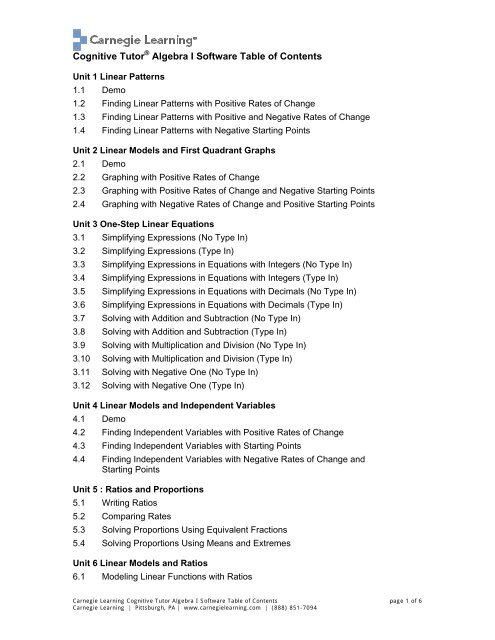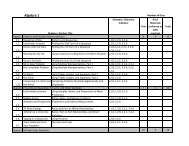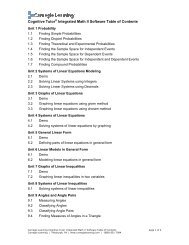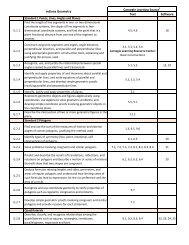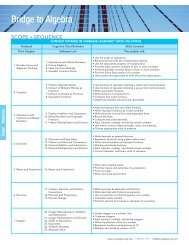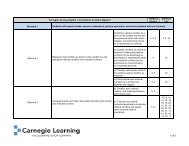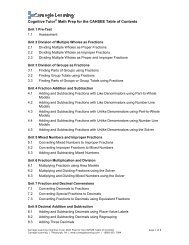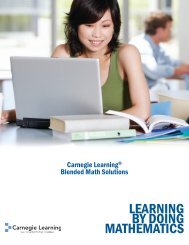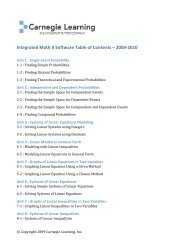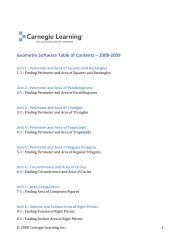Cognitive Tutor® Algebra I Software Table of Contents - Carnegie ...
Cognitive Tutor® Algebra I Software Table of Contents - Carnegie ...
Cognitive Tutor® Algebra I Software Table of Contents - Carnegie ...
You also want an ePaper? Increase the reach of your titles
YUMPU automatically turns print PDFs into web optimized ePapers that Google loves.
<strong>Cognitive</strong> Tutor ® <strong>Algebra</strong> I <strong>S<strong>of</strong>tware</strong> <strong>Table</strong> <strong>of</strong> <strong>Contents</strong><br />
Unit 1 Linear Patterns<br />
1.1 Demo<br />
1.2 Finding Linear Patterns with Positive Rates <strong>of</strong> Change<br />
1.3 Finding Linear Patterns with Positive and Negative Rates <strong>of</strong> Change<br />
1.4 Finding Linear Patterns with Negative Starting Points<br />
Unit 2 Linear Models and First Quadrant Graphs<br />
2.1 Demo<br />
2.2 Graphing with Positive Rates <strong>of</strong> Change<br />
2.3 Graphing with Positive Rates <strong>of</strong> Change and Negative Starting Points<br />
2.4 Graphing with Negative Rates <strong>of</strong> Change and Positive Starting Points<br />
Unit 3 One-Step Linear Equations<br />
3.1 Simplifying Expressions (No Type In)<br />
3.2 Simplifying Expressions (Type In)<br />
3.3 Simplifying Expressions in Equations with Integers (No Type In)<br />
3.4 Simplifying Expressions in Equations with Integers (Type In)<br />
3.5 Simplifying Expressions in Equations with Decimals (No Type In)<br />
3.6 Simplifying Expressions in Equations with Decimals (Type In)<br />
3.7 Solving with Addition and Subtraction (No Type In)<br />
3.8 Solving with Addition and Subtraction (Type In)<br />
3.9 Solving with Multiplication and Division (No Type In)<br />
3.10 Solving with Multiplication and Division (Type In)<br />
3.11 Solving with Negative One (No Type In)<br />
3.12 Solving with Negative One (Type In)<br />
Unit 4 Linear Models and Independent Variables<br />
4.1 Demo<br />
4.2 Finding Independent Variables with Positive Rates <strong>of</strong> Change<br />
4.3 Finding Independent Variables with Starting Points<br />
4.4 Finding Independent Variables with Negative Rates <strong>of</strong> Change and<br />
Starting Points<br />
Unit 5 : Ratios and Proportions<br />
5.1 Writing Ratios<br />
5.2 Comparing Rates<br />
5.3 Solving Proportions Using Equivalent Fractions<br />
5.4 Solving Proportions Using Means and Extremes<br />
Unit 6 Linear Models and Ratios<br />
6.1 Modeling Linear Functions with Ratios<br />
<strong>Carnegie</strong> Learning <strong>Cognitive</strong> Tutor <strong>Algebra</strong> I <strong>S<strong>of</strong>tware</strong> <strong>Table</strong> <strong>of</strong> <strong>Contents</strong> page 1 <strong>of</strong> 6<br />
<strong>Carnegie</strong> Learning | Pittsburgh, PA | www.carnegielearning.com | (888) 851-7094
<strong>Cognitive</strong> Tutor ® <strong>Algebra</strong> I <strong>S<strong>of</strong>tware</strong> <strong>Table</strong> <strong>of</strong> <strong>Contents</strong><br />
Unit 7 Two-Step Linear Equations<br />
7.1 Solving with Multiplication (No Type In)<br />
7.2 Solving with Multiplication (Type In)<br />
7.3 Solving with Division (No Type In)<br />
7.4 Solving with Division (Type In)<br />
7.5 Solving with a Variable in the Denominator (No Type In)<br />
7.6 Solving with a Variable in the Denominator (Type In)<br />
Unit 8 : Linear Models and Two Quadrant Graphs<br />
8.1 Demo<br />
8.2 Graphing with Positive Integer Rates <strong>of</strong> Change<br />
8.3 Graphing with Positive Fractional Rates <strong>of</strong> Change<br />
8.4 Graphing with Negative Rates <strong>of</strong> Change<br />
Unit 9 Linear Equations with Similar Terms<br />
9.1 Solving by Combining Like Variable Terms and a Constant with Integers<br />
(No Type In)<br />
9.2 Solving by Combining Like Variable Terms and a Constant with Integers<br />
(Type In)<br />
9.3 Solving by Combining Like Variable Terms with Decimals (No Type In)<br />
9.4 Solving by Combining Like Variable Terms with Decimals (Type In)<br />
9.5 Solving by Combining Like Variable Terms and a Constant with Decimals<br />
(No Type In)<br />
9.6 Solving by Combining Like Variable Terms and a Constant with Decimals<br />
(Type In)<br />
Unit 10 Linear Equations and the Distributive Property<br />
10.1 Using Multiplication and Integers (No Type In)<br />
10.2 Using Multiplication and Integers (Type In)<br />
10.3 Using Multiplication and Decimals (No Type In)<br />
10.4 Using Multiplication and Decimals (Type In)<br />
10.5 Using Multiplication and Large Decimals (No Type In)<br />
10.6 Using Multiplication and Large Decimals (Type In)<br />
10.7 Using Division (No Type In)<br />
10.8 Using Division (Type In)<br />
10.9 Using Division with Additional Variable Term (No Type In)<br />
10.10 Using Division with Additional Variable Term (Type In)<br />
<strong>Carnegie</strong> Learning <strong>Cognitive</strong> Tutor <strong>Algebra</strong> I <strong>S<strong>of</strong>tware</strong> <strong>Table</strong> <strong>of</strong> <strong>Contents</strong> page 2 <strong>of</strong> 6<br />
<strong>Carnegie</strong> Learning | Pittsburgh, PA | www.carnegielearning.com | (888) 851-7094
<strong>Cognitive</strong> Tutor ® <strong>Algebra</strong> I <strong>S<strong>of</strong>tware</strong> <strong>Table</strong> <strong>of</strong> <strong>Contents</strong><br />
Unit 11 Linear Models and the Distributive Property<br />
11.1 Demo<br />
11.2 Modeling with Integer Rates <strong>of</strong> Change<br />
11.3 Modeling with Fractional Rates <strong>of</strong> Change<br />
11.4 Modeling using the Distributive Property over Division<br />
11.5 Modeling More Complex Equations<br />
Unit 12 Rational and Irrational Numbers<br />
12.1 Creating Number Line Models<br />
12.2 Ordering Rational and Irrational Numbers<br />
Unit 13 Linear Models and Slope-Intercept Graphs A<br />
13.1 Demo<br />
13.2 Graphing given an Integer Slope and Y-intercept<br />
13.3 Graphing given a Fractional Slope and Y-intercept<br />
Unit 14 Linear Models using Two Points<br />
14.1 Demo<br />
14.2 Modeling Given an Initial Point<br />
14.3 Modeling Given Two Points<br />
14.4 Modeling Given Two Points or an Initial Point<br />
Unit 15 General Linear Form<br />
15.1 Demo<br />
15.2 Defining parts <strong>of</strong> linear equations in general form<br />
Unit 16 Linear Models in General Form<br />
16.1 Demo<br />
16.2 Modeling linear equations in general form<br />
Unit 17 Literal Equations<br />
17.1 Solving Literal Equations with Variable Terms on the Same Side (No<br />
Type In)<br />
17.2 Solving Literal Equations with Variable Terms on the Same Side (Type In)<br />
17.3 Solving Literal Equations with Variable Terms on Opposite Sides (No<br />
Type In)<br />
17.4 Solving Literal Equations with Variable Terms on Opposite Sides (Type<br />
In)<br />
17.5 Solving literal equations (No Type In)<br />
17.6 Solving literal equations (Type In)<br />
<strong>Carnegie</strong> Learning <strong>Cognitive</strong> Tutor <strong>Algebra</strong> I <strong>S<strong>of</strong>tware</strong> <strong>Table</strong> <strong>of</strong> <strong>Contents</strong> page 3 <strong>of</strong> 6<br />
<strong>Carnegie</strong> Learning | Pittsburgh, PA | www.carnegielearning.com | (888) 851-7094
<strong>Cognitive</strong> Tutor ® <strong>Algebra</strong> I <strong>S<strong>of</strong>tware</strong> <strong>Table</strong> <strong>of</strong> <strong>Contents</strong><br />
Unit 18 Linear Equations with Variables on Both Sides<br />
18.1 Reviewing Solving Equations with Multiplication (No Type In)<br />
18.2 Reviewing Solving Equations with Multiplication (Type In)<br />
18.3 Reviewing Solving Equations with Division (No Type In)<br />
18.4 Reviewing Solving Equations with Division (Type In)<br />
18.5 Solving with Integers (No Type In)<br />
18.6 Solving with Integers (Type In)<br />
18.7 Solving with Decimals (No Type In)<br />
18.8 Solving with Decimals (Type In)<br />
18.9 Solving with Large Decimals (No Type In)<br />
18.10 Solving with Large Decimals (Type In)<br />
Unit 19 Systems <strong>of</strong> Linear Equations Modeling<br />
19.1 Demo<br />
19.2 Solving Linear Systems using Integers<br />
19.3 Solving Linear Systems using Decimals<br />
Unit 20 Systems <strong>of</strong> Linear Equations<br />
20.1 Demo<br />
20.2 Solving systems <strong>of</strong> linear equations by graphing<br />
Unit 21 Graphs <strong>of</strong> Linear Inequalities<br />
21.1 Demo<br />
21.2 Graphing linear inequalities in two variables<br />
Unit 22 Systems <strong>of</strong> Linear Inequalities<br />
22.1 Solving systems <strong>of</strong> linear inequalities<br />
Unit 23 Quadratic Models and Area<br />
23.1 Modeling Quadratic Functions as Area<br />
Unit 24 Squares and Square Roots<br />
24.1 Finding Perfect Squares and Square Roots<br />
24.2 Approximating Square Roots<br />
Unit 25 Quadratic Equation Solving<br />
25.1 Solving Quadratic Equations<br />
Unit 26 Quadratic Models and Vertical Motion<br />
26.1 Using the Vertical Motion Model<br />
<strong>Carnegie</strong> Learning <strong>Cognitive</strong> Tutor <strong>Algebra</strong> I <strong>S<strong>of</strong>tware</strong> <strong>Table</strong> <strong>of</strong> <strong>Contents</strong> page 4 <strong>of</strong> 6<br />
<strong>Carnegie</strong> Learning | Pittsburgh, PA | www.carnegielearning.com | (888) 851-7094
<strong>Cognitive</strong> Tutor ® <strong>Algebra</strong> I <strong>S<strong>of</strong>tware</strong> <strong>Table</strong> <strong>of</strong> <strong>Contents</strong><br />
Unit 27 Exponents<br />
27.1 Writing Numbers as Positive Powers <strong>of</strong> Ten<br />
27.2 Writing Numbers as Positive Powers <strong>of</strong> Bases Other than Ten<br />
27.3 Writing Numbers as Negative Powers <strong>of</strong> Ten<br />
27.4 Writing Numbers as Negative Powers <strong>of</strong> Bases Other than Ten<br />
27.5 Writing Numbers as Powers <strong>of</strong> Bases<br />
Unit 28 Scientific Notation<br />
28.1 Writing Numbers in Scientific Notation with Whole Numbers and Positive<br />
Exponents<br />
28.2 Writing Numbers in Scientific Notation with Decimals and Positive<br />
Exponents<br />
28.3 Writing Numbers in Scientific Notation with Whole Numbers and Negative<br />
Exponents<br />
28.4 Writing Numbers in Scientific Notation with Decimals and Negative<br />
Exponents<br />
28.5 Writing Numbers in Scientific Notation<br />
28.6 Comparing Numbers Written in Scientific Notation<br />
Unit 29 Product Rule for Exponents<br />
29.1 Using the Product Rule with a Coefficient <strong>of</strong> One<br />
29.2 Using the Product Rule with Coefficients<br />
29.3 Using the Product Rule with Multiple Variables<br />
Unit 30 Quotient Rule for Exponents<br />
30.1 Using the Quotient Rule with a Coefficient <strong>of</strong> One<br />
30.2 Using the Quotient Rule with Coefficients<br />
30.3 Using the Quotient Rule with Multiple Variables<br />
Unit 31 Polynomial Addition and Subtraction<br />
31.1 Adding polynomials<br />
31.2 Adding polynomials with higher orders<br />
31.3 Subtracting polynomials<br />
Unit 32 Quadratics Factoring<br />
32.1 Factoring trinomials with coefficients <strong>of</strong> one<br />
32.2 Factoring trinomials with positive coefficients<br />
Unit 33 Rational Expressions<br />
33.1 Simplifying rational expressions<br />
33.2 Multiplying and dividing rational expressions<br />
33.3 Adding and subtracting rational expressions<br />
<strong>Carnegie</strong> Learning <strong>Cognitive</strong> Tutor <strong>Algebra</strong> I <strong>S<strong>of</strong>tware</strong> <strong>Table</strong> <strong>of</strong> <strong>Contents</strong> page 5 <strong>of</strong> 6<br />
<strong>Carnegie</strong> Learning | Pittsburgh, PA | www.carnegielearning.com | (888) 851-7094
<strong>Cognitive</strong> Tutor ® <strong>Algebra</strong> I <strong>S<strong>of</strong>tware</strong> <strong>Table</strong> <strong>of</strong> <strong>Contents</strong><br />
Unit 34 Probability<br />
34.1 Finding Simple Probabilities<br />
34.2 Finding Disjoint Probabilities<br />
34.3 Finding Theoretical and Experimental Probabilities<br />
34.4 Finding the Sample Space for Independent Events<br />
34.5 Finding the Sample Space for Dependent Events<br />
34.6 Finding the Sample Space for Independent and Dependent Events<br />
34.7 Finding Compound Probabilities<br />
Unit 35 Measures <strong>of</strong> Central Tendency<br />
35.1 Finding Mean, Median, Mode, and Range<br />
35.2 Determining Appropriate Measures<br />
35.3 Measuring the Effects <strong>of</strong> Changing Data Sets<br />
35.4 Finding a Data Value Given a Mean<br />
Unit 36 Pythagorean Theorem<br />
36.1 Finding the Length <strong>of</strong> the Hypotenuse <strong>of</strong> a Right Triangle<br />
36.2 Finding the Length <strong>of</strong> a Leg <strong>of</strong> a Right Triangle<br />
36.3 Using the Pythagorean Theorem<br />
Unit 37 Linear and Quadratic Transformations<br />
37.1 Shifting vertically using verbal statements<br />
37.2 Shifting vertically using graphs<br />
37.3 Shifting vertically using equations<br />
37.4 Reflecting and dilating using graphs<br />
37.5 Reflecting and dilating using equations<br />
37.6 Shifting horizontally<br />
37.7 Transforming using verbal statements and equations<br />
37.8 Transforming using graphs<br />
37.9 Using two or less transformations using tables <strong>of</strong> values<br />
37.10 Transforming using verbal statements, graphs, and equations<br />
37.11 Using three or less transformations using tables <strong>of</strong> values<br />
Unit 38 Exponential Modeling<br />
38.1 Demo<br />
38.2 Modeling equations with starting point <strong>of</strong> one<br />
38.3 Modeling equations with starting point other than one<br />
38.4 Using regression models<br />
<strong>Carnegie</strong> Learning <strong>Cognitive</strong> Tutor <strong>Algebra</strong> I <strong>S<strong>of</strong>tware</strong> <strong>Table</strong> <strong>of</strong> <strong>Contents</strong> page 6 <strong>of</strong> 6<br />
<strong>Carnegie</strong> Learning | Pittsburgh, PA | www.carnegielearning.com | (888) 851-7094


